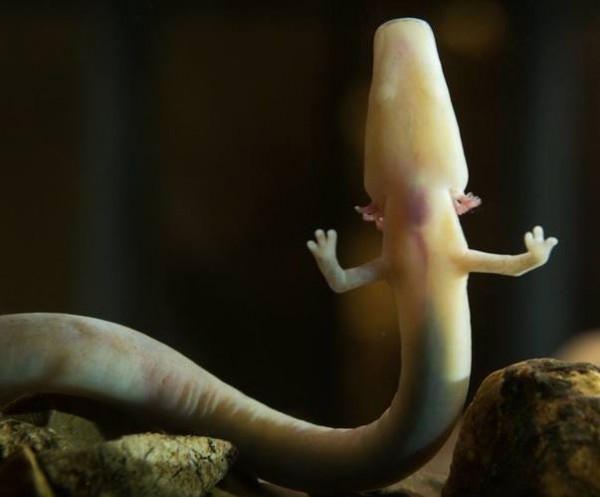Rare 'Baby Dragons' Give Birth Inside Ancient Cave in Slovenia
| Ellie Froilan | | Jun 06, 2016 04:41 AM EDT |
(Photo : Reuters) Olms are rare salamanders which are completely blind and only reproduce once every five to ten years.
Two baby olms were seen in a live camera being hatched, keeping close tabs on the eggs throughout their incubation.
Olms are rare salamanders which are completely blind, and their distinctive features also include a ghostly pallor, a peculiar reproductive cycle, and an extraordinarily long lifespan allowing them to outlive most humans. They are also known as “baby dragons” because of their unique appearance.
Like Us on Facebook
The eggs were found at popular tourist destination that has its own aquarium Postojna Cave in Slovenia, where the salamanders have lived for thousands of years, and on the last week of May, the first of the 23 eggs in the clutch had hatched. A second olm had hatched from its egg earlier this month.
For the past four months, biologists have been closely watching a clutch of “dragon” eggs. It is a rare opportunity for scientists to observe such an event because “baby dragons” only reproduce once every five to ten years. Incredibly, these endangered amphibians can go over a decade without food.
“We took care of the eggs non-stop, observing them, connecting scientific findings with our own experience.... We had to take decisions nobody had taken before. Everything was new,” Postojna Cave Park said in the announcement.
The Postojna staff are working with amphibian experts from France, who have studied the olms in an underground mountain lab since the 1950s. The French lab is the only other place where olms have been observed emerging from their eggs. In nature, no one has ever witnessed an olm younger than two years.
A total of 64 eggs were found in the cave in January, but only 23 of them have been considered viable, or capable of hatching. This may sound like a low percentage, but olms in the wild are known to have only one or two viable eggs out of a clutch of 250, or easily less than one percent. While a mere two baby olms have hatched so far, the researchers are optimistic that more healthy larvae may appear in the days to come.
Tagsbaby dragons, olms, dragons, slovenia, Ancient Slovenian cave, salamander, Postojna Cave
©2015 Chinatopix All rights reserved. Do not reproduce without permission
EDITOR'S PICKS
-

Did the Trump administration just announce plans for a trade war with ‘hostile’ China and Russia?
-

US Senate passes Taiwan travel bill slammed by China
-

As Yan Sihong’s family grieves, here are other Chinese students who went missing abroad. Some have never been found
-

Beijing blasts Western critics who ‘smear China’ with the term sharp power
-

China Envoy Seeks to Defuse Tensions With U.S. as a Trade War Brews
-

Singapore's Deputy PM Provides Bitcoin Vote of Confidence Amid China's Blanket Bans
-

China warns investors over risks in overseas virtual currency trading
-

Chinese government most trustworthy: survey
-

Kashima Antlers On Course For Back-To-Back Titles
MOST POPULAR
LATEST NEWS
Zhou Yongkang: China's Former Security Chief Sentenced to Life in Prison

China's former Chief of the Ministry of Public Security, Zhou Yongkang, has been given a life sentence after he was found guilty of abusing his office, bribery and deliberately ... Full Article
TRENDING STORY

China Pork Prices Expected to Stabilize As The Supplies Recover

Elephone P9000 Smartphone is now on Sale on Amazon India

There's a Big Chance Cliffhangers Won't Still Be Resolved When Grey's Anatomy Season 13 Returns

Supreme Court Ruled on Samsung vs Apple Dispute for Patent Infringement

Microsoft Surface Pro 5 Rumors and Release Date: What is the Latest?












